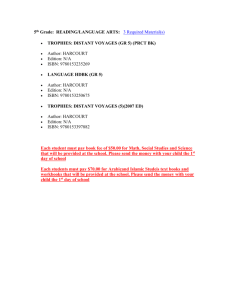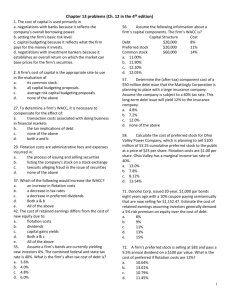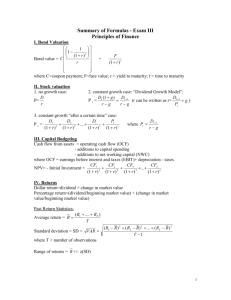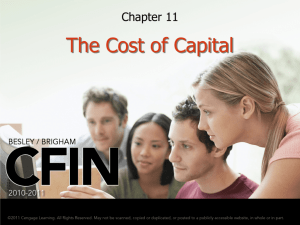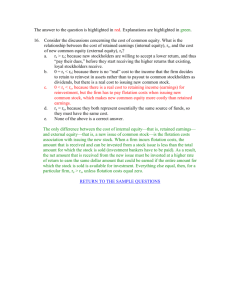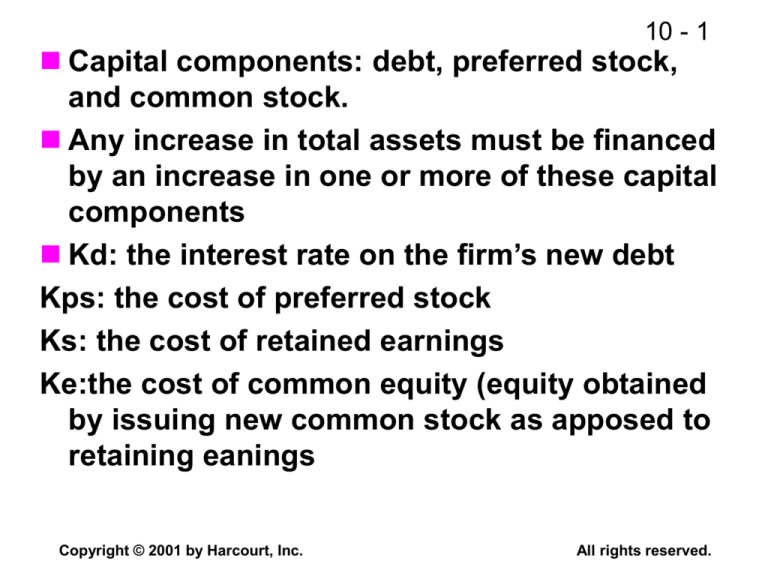
10 - 1
Capital components: debt, preferred stock,
and common stock.
Any increase in total assets must be financed
by an increase in one or more of these capital
components
Kd: the interest rate on the firm’s new debt
Kps: the cost of preferred stock
Ks: the cost of retained earnings
Ke:the cost of common equity (equity obtained
by issuing new common stock as apposed to
retaining eanings
Copyright © 2001 by Harcourt, Inc.
All rights reserved.
10 - 2
1. The cost of debt
Kd(1-T) is the after tax cost of debt. The
relevant cost of new debt, taking into
account the tax deductibility of interest.
In effect, the government pays part of the
cost of debt because interest is
deductible.
Note that the cost of debt is the interest
rate on new debt, not the interest rate
paid on existing or old debt.
Copyright © 2001 by Harcourt, Inc.
All rights reserved.
10 - 3
A 15-year, 12% semiannual bond sells
for $1,153.72. What’s kd?
0
1
2
30
i=?
...
60
-1,153.72
INPUTS
30
N
OUTPUT
60
-1153.72 60
I/YR
PV
PMT
60 + 1,000
1000
FV
5.0% x 2 = kd = 10%
Copyright © 2001 by Harcourt, Inc.
All rights reserved.
10 - 4
Component Cost of Debt
Interest is tax deductible, so
kd AT = kd BT(1 – T)
= 10%(1 – 0.40) = 6%.
Copyright © 2001 by Harcourt, Inc.
All rights reserved.
10 - 5
2. The cost of preferred stock (Kp)
The rate of return investors require on the
firm’s preferred stock.
Preferred stock is a perpetuity that pays a
fixed dividend (Dp) forever.
Kp = Preferred dividend / the current price
of the preferred stock
Copyright © 2001 by Harcourt, Inc.
All rights reserved.
10 - 6
What’s the cost of preferred stock?
Pp = $111.10; $10 dividend/share
Use this formula:
Dp
$10
kp
0.090 9.0%.
Pp $111.10
Copyright © 2001 by Harcourt, Inc.
All rights reserved.
10 - 7
Note:
Preferred dividends are not tax
deductible, so no tax adjustment.
Just kp.
Nominal kp is used.
Our calculation ignores flotation
costs.
Copyright © 2001 by Harcourt, Inc.
All rights reserved.
10 - 8
Why is there a cost for retained
earnings?
Earnings can be reinvested or paid
out as dividends.
Investors could buy other securities,
earn a return.
Thus, there is an opportunity cost if
earnings are retained.
Copyright © 2001 by Harcourt, Inc.
All rights reserved.
10 - 9
Opportunity cost: The return
stockholders could earn on
alternative investments of equal risk.
They could buy similar stocks and
earn ks. So, ks is the cost of retained
earnings. The rate of return required by
stockholders on a firm’s common stock
Copyright © 2001 by Harcourt, Inc.
All rights reserved.
10 - 10
Three ways to determine cost of
common equity, ks:
1. CAPM: ks = kRF + (kM – kRF)b.
2. The bond-yield plus risk-premium approach:
Ks= bond yield + firm’s risk premium
firms with risky, low-rated, and consequently
high-interest-rate debt will also have risky, highcost equity. The risk premium over a firm’s own
bond yield has generally ranged from 3 to 5
percentage.
Copyright © 2001 by Harcourt, Inc.
All rights reserved.
10 - 11
3. Discount Cash Flow model
(Constant dividend growth model)
Ks = (D1/Po) + g
How to estimate g?
g = (1- dividend pay out ratio)*ROE
Copyright © 2001 by Harcourt, Inc.
All rights reserved.
10 - 12
What’s the cost of common equity
based on the CAPM?
kRF = 7%, RPM = 6%, b = 1.2.
ks = kRF + (kM – kRF )b.
= 7.0% + (6.0%)1.2 = 14.2%.
Copyright © 2001 by Harcourt, Inc.
All rights reserved.
10 - 13
What’s the DCF cost of common
equity, ks? Given: D0 = $4.19;
P0 = $50; g = 5%.
D1
D0(1 + g)
ks =
+g=
+g
P0
P0
$4.19(1.05)
=
+ 0.05
$50
= 0.088 + 0.05
= 13.8%.
Copyright © 2001 by Harcourt, Inc.
All rights reserved.
10 - 14
Suppose the company has been
earning 15% on equity (ROE = 15%)
and retaining 35% (dividend payout =
65%), and this situation is expected to
continue.
What’s the expected future g?
Copyright © 2001 by Harcourt, Inc.
All rights reserved.
10 - 15
Retention growth rate:
g = (1 – Payout)(ROE) = 0.35(15%)
= 5.25%.
Here (1 – Payout) = Fraction retained.
Copyright © 2001 by Harcourt, Inc.
All rights reserved.
10 - 16
Find ks using the own-bond-yield-plusrisk-premium method.
(kd = 10%, RP = 4%.)
ks = kd + RP
= 10.0% + 4.0% = 14.0%
This RP CAPM RP.
Produces ballpark estimate of ks.
Copyright © 2001 by Harcourt, Inc.
All rights reserved.
10 - 17
What’s a reasonable final estimate of ks?
Method
Estimate
CAPM
14.2%
DCF
13.8%
kd + RP
14.0%
Average
Copyright © 2001 by Harcourt, Inc.
14.0%
All rights reserved.
10 - 18
Why is the cost of retained earnings
(ks) cheaper than the cost of issuing
new common stock (ke)?
1. When a company issues new common
stock they also have to pay flotation costs
to the underwriter.
2. Issuing new common stock may send a
negative signal to the capital markets,
which may depress stock price.
Copyright © 2001 by Harcourt, Inc.
All rights reserved.
10 - 19
Two approaches that can be used to
account for flotation costs:
Include the flotation costs as part of the
project’s up-front cost. This reduces the
project’s estimated return.
Adjust the cost of capital to include
flotation costs. This is most commonly
done by incorporating flotation costs in
the DCF model.
Copyright © 2001 by Harcourt, Inc.
All rights reserved.
10 - 20
Ke = [D1/Po(1-F) ] + g
F is the percentage flotation cost incurred in
selling the new stock.
So, Po (1-F) is the net price per share
received by the company.
Copyright © 2001 by Harcourt, Inc.
All rights reserved.
10 - 21
New common, F = 15%:
D0 (1 g)
ke
g
P0 (1 F)
$4.191.05
5 .0 %
$501 0.15
$4.40
5.0% 15.4%.
$42.50
Copyright © 2001 by Harcourt, Inc.
All rights reserved.
10 - 22
Because of flotation costs, dollars raised by
selling new stock must “work harder” than
dollars raised by retaining earnings.
Moreover, since no flotation costs are
involved, retained earnings have a lower cost
than new stock.
Therefore, the firms should utilize retained
earnings to the extent possible to avoid the
costs of new common stock.
However, if a firm has more good investment
opportunities, issuing new common stock is
necessary.
Copyright © 2001 by Harcourt, Inc.
All rights reserved.
10 - 23
The retained earnings breakpoint represents
the total amount of financing that can be
raised before the firm is forced to sell new
common stock.
Retained earnings breakpoint
= addition to retained earnings/equity fraction
Copyright © 2001 by Harcourt, Inc.
All rights reserved.
10 - 24
E.g) Suppose a firm estimates its
earnings to be $100M next year and
has a payout ratio of 40%. Its capital
structure consists of 45% debt, 2%
preferred, and 53% equity.
The break point will be $60M/0.53 =
$113.2M; After the firm has raised
total capital of $113.2M, the firm will
be forced to issue new common
stock.
Copyright © 2001 by Harcourt, Inc.
All rights reserved.
10 - 25
Comments about flotation costs:
Flotation costs depend on the risk of
the firm and the type of capital being
raised.
The flotation costs are highest for
common equity. However, since
most firms issue equity infrequently,
the per-project cost is fairly small.
We will frequently ignore flotation
costs when calculating the WACC.
Copyright © 2001 by Harcourt, Inc.
All rights reserved.
10 - 26
5. Weighted Average Cost of Capital (WACC)
If all new equity will come from retained earnings:
WACC = Wd [Kd(1-t)] + Wp(Kps) + Wc(Ks)
Wd, Ws, Wc are the weights used for debt, preferred
stock, and common equity.
Assume that the firm has established such a target
and will finance all new investments so as to
maintain a constant target capital structure.
Weights should be based on the market value.
Copyright © 2001 by Harcourt, Inc.
All rights reserved.
10 - 27
What’s the firm’s WACC (ignoring
flotation costs)?
WACC = wdkd(1 – T) + wpkp + wcks
= 0.3(10%)(0.6) + 0.1(9%) + 0.6(14%)
= 1.8% + 0.9% + 8.4% = 11.1%.
Copyright © 2001 by Harcourt, Inc.
All rights reserved.
10 - 28
The company has a target capital
structure of 40 percent debt and 60
percent equity
Bonds pay 10% coupon (semiannual),
mature in 20 years and sell for $849.54
the company stock beta is 1.2
rf = 10%, market risk premium = 5%
the company is a constant growth firm
that just paid a dividend of $2, sells for
$27 per share, and a growth rate of 8%
marginal tax rate is 40%.
Copyright © 2001 by Harcourt, Inc.
All rights reserved.
10 - 29
What factors influence a company’s
composite WACC?
Market conditions. (the level of interest
rates, tax rates…)
The firm’s capital structure and dividend
policy.
The firm’s investment policy. Firms with
riskier projects generally have a higher
WACC.
Copyright © 2001 by Harcourt, Inc.
All rights reserved.
10 - 30
WACC Estimates for Some Large
U. S. Corporations, Nov. 1999
Company
Intel
General Electric
Motorola
Coca-Cola
Walt Disney
AT&T
Wal-Mart
Exxon
H. J. Heinz
BellSouth
Copyright © 2001 by Harcourt, Inc.
WACC
12.9%
11.9
11.3
11.2
10.0
9.8
9.8
8.8
8.5
8.2
All rights reserved.
10 - 31
Should the company use the
composite WACC as the hurdle rate for
each of its projects?
NO! The composite WACC reflects the
risk of an average project undertaken
by the firm. Therefore, the WACC only
represents the “hurdle rate” for a
typical project with average risk.
Different projects have different risks.
The project’s WACC should be adjusted
to reflect the project’s risk.
Copyright © 2001 by Harcourt, Inc.
All rights reserved.
10 - 32
What procedures are used to determine
the risk-adjusted cost of capital for a
particular project or division?
Subjective adjustments to the
firm’s composite WACC.
Attempt to estimate what the cost
of capital would be if the
project/division were a stand-alone
firm. This requires estimating the
project’s beta.
Copyright © 2001 by Harcourt, Inc.
All rights reserved.
10 - 33
Find the division’s market risk and cost
of capital based on the CAPM, given
these inputs:
Target debt ratio = 40%.
kd = 12%.
kRF = 7%.
Tax rate = 40%.
betaDivision = 1.7.
Market risk premium = 6%.
Copyright © 2001 by Harcourt, Inc.
All rights reserved.
10 - 34
Beta = 1.7, so division has more market
risk than average.
Division’s required return on equity:
ks = kRF + (kM – kRF)bDiv.
= 7% + (6%)1.7 = 17.2%.
WACCDiv. = wdkd(1 – T) + wcks
= 0.4(12%)(0.6) + 0.6(17.2%)
= 13.2%.
Copyright © 2001 by Harcourt, Inc.
All rights reserved.
10 - 35
How does the division’s market risk
compare with the firm’s overall market
risk?
Division WACC = 13.2% versus
company WACC = 11.1%.
Indicates that the division’s market risk
is greater than firm’s average project.
“Typical” projects within this division
would be accepted if their returns are
above 13.2%.
Copyright © 2001 by Harcourt, Inc.
All rights reserved.


